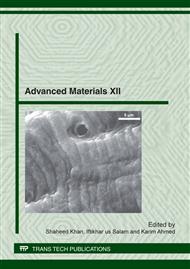p.301
p.307
p.315
p.321
p.330
p.335
p.343
p.348
p.356
Anomalous Behavior of Chemically Synthesized Magnetoplumbite Strontium Ferrite Nano Particles
Abstract:
Strontium hexa-ferrite nanoparticles were prepared successfully by simple co-precipitation method. The XRD analysis confirmed the formation of single phase MFe12O19 (M=Sr). Parameters such as crystallite size, lattice constant, X-ray density and porosity were calculated from the X-ray diffraction data. The crystallite sizes were in the range 12-26 nm. The temperature dependent dc electrical resistivity measurements showed that the material was highly. Dielectric constant and dielectric loss factor (tanδ) were measured in the frequency range 20Hz-3MHz. The anomalous behavior of dielectric loss revealed a very important behavior of the prepared sample of SrFe12O19 in different frequency regions and that could be used for new applications of this material. The magnetic properties were determined from the hystersis loop obtained from vibrating sample magnetometer (VSM). The Curie temperature was determined by susceptometer. This material is potentially suitable for use as a recording medium in identification cards and credit cards and for the fabrication of permanent magnets.
Info:
Periodical:
Pages:
330-334
Citation:
Online since:
May 2012
Authors:
Price:
Сopyright:
© 2012 Trans Tech Publications Ltd. All Rights Reserved
Share:
Citation:


